|
|
Home →
Survival →
Fire →
Tinder
Finding Dry Tinder
Photos and text by Zeb Allison |
|
|
|
Finding dry tinder material for a "birds nest" can be very
difficult. It might not be as hard to do on a sunny day when you
are in good health and you arenít hungry, but imagine the
situation where you had a plane crash, fell and broke your leg
or wrist. And if you have a lighter you are already at an
advantage. A lighter gives you something that almost nothing
else can, a flame.
Now with a bow drill hand drill or ferro rod you have the
potential to get a fire, it can be done but never bet your life
on it. With a lighter you have a flame, with primitive friction
fire you get a coal, and with the ferro rod you get sparks.
True, the coal or sparks are hot but youíve got to remember that
water won't burn!
There are many ways to find dry tinder, or just tinder
itself. That is what I will be discussing in this article -
finding the right materials. When you think of tinder you
probably think wood chips or cotton. Well that works but more
often than not you wonít have cotton or wood chips. Tinder
preferably is a dry fluffy substance used to make a flame spark
or coal into a flame. So with that said it's time to discuss the
tinder.
|
|
|
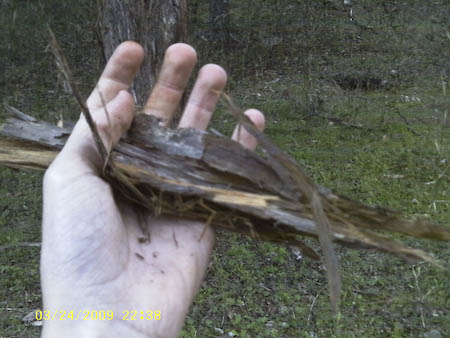 |
Cedar & Cottonwood
I think my first resource when finding tinder in my
neck of the woods is cedar bark, see photo 1. What
you want from the cedar is the inner bark. This
layer is almost always bone dry. One thing you can
do with it is to tear it into thin strips and rub it
against each other in your hands. Got an injured
hand? Rub the bark on a rough rock. No rough rock?
Rub it on your boot. No boot? Well you better hope
you donít need tinder if you donít have boots!! |
|
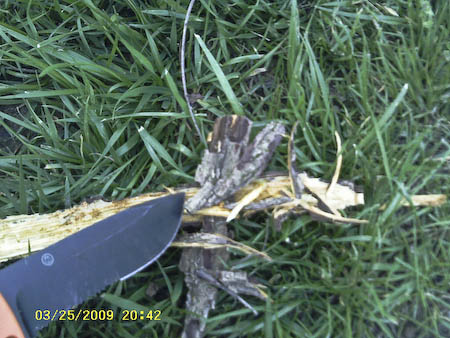 |
If I couldnít find a
cedar tree I would look for a cottonwood. The inner
layer of cottonwood bark is good for many things:
rope, tinder, and twine are just a few. But in this
article it is just the tinder we are concerned
about. What you do is simply take a knife, hatchet,
machete, or whatever else you have and cut off a
large chunk of it. See photo 2. Now the next step is
to strip off the cord-like strands of the inner
bark. These should be dry unless it has just rained.
If it has just rained shove them in your shirt and
your body heat should dry them off shortly.
I think that sums up cedar and cottonwood for
tinder, now on to my next tinder resource.
|
|
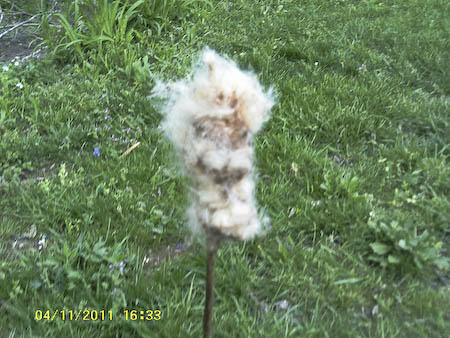 |
Cattail & Leaves
Before I discuss leaves I will go over cattails.
Cattails themselves are not the tinder. It is the
head you want. See photo 3. Cattails grow throughout
North America and in some other countries. Cattails
tend to grow near slow or still moving water. Once
you find the cattail grab it below the head and give
it a quick snap.
|
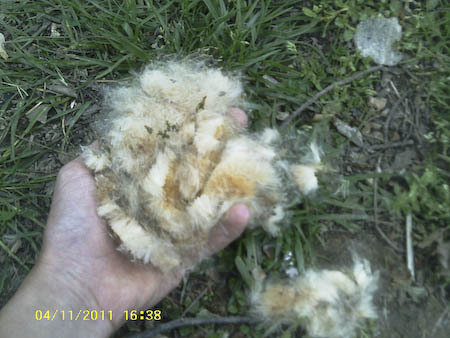 |
Depending on the time
of year and weather the cattail head may be busted
open. If it is just take the fuzz off of the head -
this is the tinder you want. See photo 4. It doesnít
really matter if it is wet or not but if it is just
put it in your coat for about five minutes. This
type of tinder ignites better than cotton and is
easier to find than cotton. |
|
| The next type of tinder I will discuss is
leaves. Leaves are not the best tinder ever, but if you know
what youíre looking for they can work. Most people would look
for leaves say under a tree, or on the forest floor. This can
work, but what if it has just rained? You could put them in your
coat but they dry off slowly - they need time to dry. So your
only option is to find them where they are dry. |
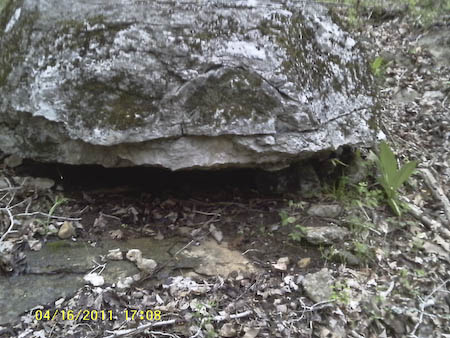 |
But where to look? If
it is raining, where is there a dry place? Caves and
large crevasses under rocks. See photo 5. Oftentimes
animals will make these spaces their homes. If they
have then they picked that spot because it is warm
and dry. And that is the perfect place to look for
leaves. Oftentimes animals will bring in fluffy
things such as cotton or animal fur. All you need to
do is look under the rock or cave and pull out a
couple of handfuls and there you go - warm, dry,
ready-to-ignite tinder. Now, with that being said,
please donít use this technique unless you really
need to. A handful of tinder to an animal is a day
of work and a night of coldness. Now on to my next
resource. |
|
Char cloth & Bamboo
Char cloth is probably the ultimate tinder. Char cloth is
made by putting cotton cloth in a sealed airtight container. A
metal water bottle works great. You cut the cloth into pieces
about 1" by 1" and put it into the container. Make sure no air
can get in. Then put the container on a bed of hot coals for
about 5 minutes. Take it off of the coals but donít take off the
lid until the container has cooled off. Once it has cooled off,
take off the lid and remove the cloth squares. They should be
black. If they are not, repeat the first step until they are.
|
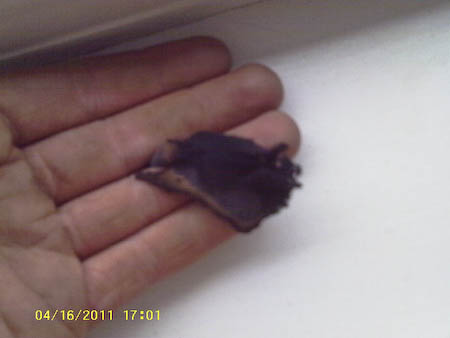 |
This type of tinder should be pre-made and packed in your
survival kit. The reason they turn black is because the heat
takes out the impurities of the cloth, leaving nothing but dry
cotton behind. See photo 6. This type of tinder will take the
tiniest spark you can imagine. If you have a good carbon steel
knife and a piece of flint the char cloth will take it.
|
|
|
Now on to Bamboo. Bamboo is not a very common resource of
tinder but it can be used to some extent. The bamboo itself is
not what you want, it is the shavings. Hold your knife at a 90
degree angle over the bamboo and rub it back and forth over it.
This should create something that looks like sawdust except
fluffier. This is more of a lighter or ferro rod type tinder
although it can be used with bow drill, hand drill, and other
friction fire methods.
There is also a tinder for bow drill or hand drill called the
one leaf tinder bundle but it is very difficult to explain, and
very hard to use. It is best to just stick to the tinder
materials that I have discussed.
That sums up this article but never forget be creative.
Survival and bush craft is all about thinking outside the box,
and always keeping a positive mental attitude. |
|
|
|
|
|
|